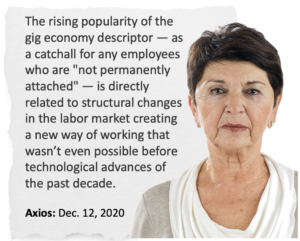 If you have a regular job, the new labor market can be hard to grasp. Irregular employment is wide-ranging; and unnecessarily hard.
If you have a regular job, the new labor market can be hard to grasp. Irregular employment is wide-ranging; and unnecessarily hard.
.
.
.
Irregulars are everywhere
This is the world of people who don’t have regular hours or pay. They can be animal caretakers, bricklayers, cashiers, dental hygienists, electricians, food servers, gaming dealers, hairdressers, industrial equipment operators, janitors, library assistants, manicurists, nursing assistants, office clerks, personal care aides, receptionists, security guards, tellers, ushers, van drivers, wait staff, x-ray scanners, yacht cleaners or zookeepers.
Someone seeking a job has an array of public services on their side. People who need, choose, or get forced into irregular work have almost none. That gap has been filled by commercial labor markets structured around short-term profits or cutting labor costs.
 Insight into this world remains sketchy. Informed estimates of irregulars in the workforce pre-pandemic ranged from 2% to 35% and above. It depended on definition used. Much activity is in the shadow economy with no data collection. But post-Covid, irregular work is overtaking standard employment for many.
Insight into this world remains sketchy. Informed estimates of irregulars in the workforce pre-pandemic ranged from 2% to 35% and above. It depended on definition used. Much activity is in the shadow economy with no data collection. But post-Covid, irregular work is overtaking standard employment for many.
.
.In this section:
→ Who are the irregular workforce? Some want irregularity, others can’t avoid it.
→ What problems do irregulars face? Uncertainty, marginalization, skimpy marketplaces.
→ What is the scale of irregular work? Numbers are significant. Data gathering less so.
